by Dan Beard
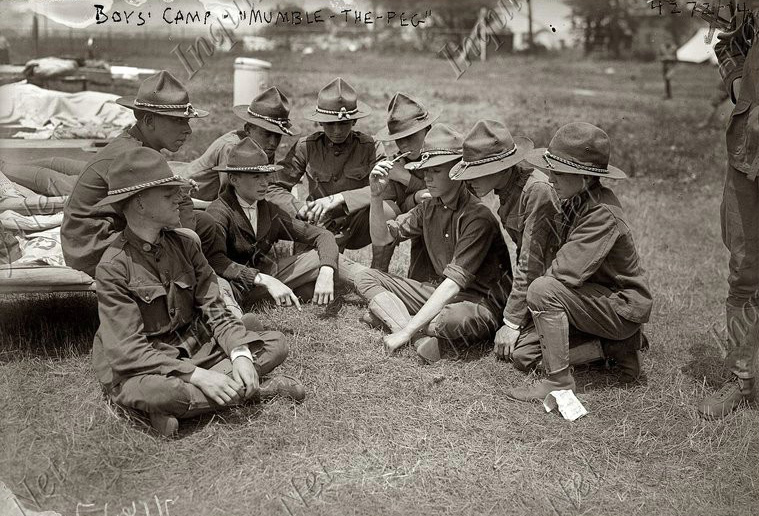

Figs. 282-283.
First Feat.
A Summer's day, a shady nook, a close-cropped green sod, two or three boys, and a jack-knife are the things necessary for a quiet game of Mumbly Peg [or mumbley peg, mumblety peg, mumble peg, mumble-the-peg, mumbypeg, or mumble de peg].
The first player takes the knife and goes through as much of the game as he can without a blunder. The second follows in turn, doing the same. The last one to perform all of the difficult feats is beaten, and must pull a peg, two inches long, from the ground with his teeth. The winner drives the peg with the knife-handle for a hammer, being allowed, by the rules of the game, three blows with his eyes open, and three with his eyes closed.
This usually drives the peg out of sight in the sod, and in that case the boys cry:
"Root! Root!"
as the defeated player, using only his teeth, literally roots, until, with a dirty face and a broad grin, he lifts his head, showing the peg between his teeth. From the penalty that the loser pays comes the name of Mumbly or Mumbelty-Peg.
The Feats
|
First: Hold the right fist with back to the ground and with the jack-knife, with blade pointing to the right, resting on top of the closed fingers (Fig. 282). The hand is swung to the right, up and over, describing a semicircle, so that the knife falls point downward and sticks, or should stick, upright in the ground (Fig. 283). If there is room to slip two fingers, one above the other, beneath the handle of the knife and if the point of the knife is hidden in the ground, it counts as a fair stick or throw. | |
|
Second: The next motion is the same as the one just described, but is performed with the left hand. | |
|
Third: Take the point of the blade between the first and second fingers of the right hand, and fillip it with a jerk so that the knife turns once around in the air and strikes the point into the ground (Fig. 284). |
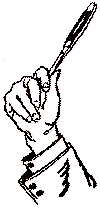
Fig. 284.
Third Feat.
|
Fourth: Do the same with the left hand. | |
|
Fifth: Hold the knife as in the third and fourth positions, and bring the arm across the chest so that the knife-handle touches the left ear. Take hold of the right ear with the left hand and fillip the knife so that it turns once or twice in the air and strikes on its point in the earth (Fig. 285). |
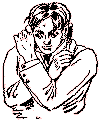
Fig. 285.
Fifth Feat.
|
Sixth: Do the same with the left hand. | |
Seventh: Still holding the knife in the same manner, bring the handle up to the nose and fillip it over through the air, so that it will stick in the ground (Fig. 286). |

Fig. 286.
Seventh Feat.
|
Eighth: Do the same with the handle at the right eye. | |
|
Ninth: Repeat, with the handle at the left eye. | |
|
Tenth: Place the point of the blade on top of the head. Hold it in place with the forefinger, and with downward push send it whirling down to the earth, where it must stick with the point of blade in the earth (Fig. 287). |
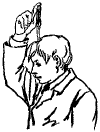
Fig. 287
Tenth Feat.
|
Eleventh to Fifteenth: Hold the left hand with the fingers pointing up, and, beginning with the thumb, place the point of the knife on each finger as described above, and the forefinger of the forefinger of the right hand on the end of the knife handle. By a downward motion, throw the knife revolving through the air, so that it will alight with the point of the blade in the sod (Fig. 288). |
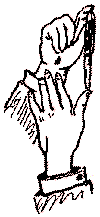
Fig. 288.
Eleventh Feat.
|
Sixteenth to Twentieth: Repeat, with the right hand up the left hand on the knife-handle. | |
|
Twenty-first, Twenty-second: the same from each knee. | |
|
Twenty-third: Hold the point of the blade between the first and second fingers and, placing the band on the forehead, flip the knife back over the head, so that it will stick in the ground behind the player ready for the next motion (Fig. 289; dotted lines show flight of knife). |

Fig. 289.
Twenty-Third Feat.
|
Twenty-fourth: After twenty-three the knife is left in the ground. Then with the palm of the hand strike the knife handle a smart blow that will send it revolving over the ground for a yard, more or less, and cause it to stick in the ground where it stops. This is called "plowing the field " (Fig. 290; dotted lines show flight of knife). |

Fig. 290.
Plowing the Field.
When a miss is made the next player takes his turn, and when the first player's turn comes again he must try the feat over that he failed to perform last. A good player will sometimes go through almost all the twenty-four motions without failing to make a " two-finger," that is, a fair stick, each time; but it is very unusual for anyone to run the game out in one inning. This is the game in twenty-four motions; many boys play it with double that number.
Also Known As:
Mumbly Peg
Mumbypeg
Mumbley Pegs
Mumblety Peg
Mumble Pegs
Mumble-the-Peg
Mumbypeg
Mumble Peg
Mumble de Peg